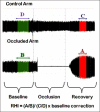Test-retest reliability of pulse amplitude tonometry measures of vascular endothelial function: implications for clinical trial design
- PMID: 22363016
- PMCID: PMC3513268
- DOI: 10.1177/1358863X11433188
Test-retest reliability of pulse amplitude tonometry measures of vascular endothelial function: implications for clinical trial design
Abstract
Endothelial dysfunction is an important outcome for assessing vascular health in intervention studies. However, reliability of the standard non-invasive method (flow-mediated dilation) is a significant challenge for clinical applications and multicenter trials. We evaluated the repeatability of pulse amplitude tonometry (PAT) to measure change in pulse wave amplitude during reactive hyperemia (Itamar Medical Ltd, Caesarea, Israel). Twenty healthy adults completed two PAT tests (mean interval = 19.5 days) under standardized conditions. PAT-derived measures of endothelial function (reactive hyperemia index, RHI) and arterial stiffness (augmentation index, AI) showed strong repeatability (intra-class correlations = 0.74 and 0.83, respectively). To guide future research, we also analyzed sample size requirements for a range of effect sizes. A crossover design powered at 0.90 requires 28 participants to detect a 15% change in RHI. Our study is the first to show that PAT measurements are repeatable in adults over an interval greater than 1 week.
Figures


Similar articles
-
Test-retest reliability of peripheral arterial tonometry in the metabolic syndrome.Diab Vasc Dis Res. 2014 May;11(3):201-7. doi: 10.1177/1479164114525971. Epub 2014 Mar 21. Diab Vasc Dis Res. 2014. PMID: 24659234 Free PMC article.
-
Variability of peripheral arterial tonometry in the measurement of endothelial function in healthy men.Clin Cardiol. 2009 Dec;32(12):700-4. doi: 10.1002/clc.20668. Clin Cardiol. 2009. PMID: 20027662 Free PMC article.
-
Reliability of peripheral arterial tonometry in patients with heart failure, diabetic nephropathy and arterial hypertension.Vasc Med. 2017 Aug;22(4):292-300. doi: 10.1177/1358863X17706752. Epub 2017 May 30. Vasc Med. 2017. PMID: 28555533
-
Evaluation of endothelial function by peripheral arterial tonometry and relation with the nitric oxide pathway.Nitric Oxide. 2014 Nov 15;42:1-8. doi: 10.1016/j.niox.2014.07.003. Epub 2014 Jul 23. Nitric Oxide. 2014. PMID: 25064180 Review.
-
Testing endothelial function and its clinical relevance.J Atheroscler Thromb. 2013;20(1):1-8. doi: 10.5551/jat.14340. Epub 2012 Sep 10. J Atheroscler Thromb. 2013. PMID: 22972428 Review.
Cited by
-
Acute effect of blueberry intake on vascular function in older subjects: Study protocol for a randomized, controlled, crossover trial.PLoS One. 2022 Dec 1;17(12):e0275132. doi: 10.1371/journal.pone.0275132. eCollection 2022. PLoS One. 2022. PMID: 36454906 Free PMC article.
-
Editorial Comment: Cardiovascular Morbi-dity in a Randomized Trial Comparing GnRH Agonist and GnRH Antagonist among Pati-ents with Advanced Prostate Cancer and Preexisting Cardiovascular Disease.Int Braz J Urol. 2020 Sep-Oct;46(5):853-854. doi: 10.1590/S1677-5538.IBJU.2020.05.09. Int Braz J Urol. 2020. PMID: 32648429 Free PMC article. No abstract available.
-
A new peripheral endothelial function measurement improves prediction of symptomatic coronary artery disease.J Int Med Res. 2020 Jun;48(6):300060520932818. doi: 10.1177/0300060520932818. J Int Med Res. 2020. PMID: 32589086 Free PMC article.
-
The impact of repetitive long-duration water immersion on vascular function.PLoS One. 2017 Jul 27;12(7):e0181673. doi: 10.1371/journal.pone.0181673. eCollection 2017. PLoS One. 2017. PMID: 28750006 Free PMC article.
-
The Role of Psychological Distress and Unhealthy Lifestyle in Angina with Nonobstructive Coronary Arteries: A Cross-Sectional Study.J Multidiscip Healthc. 2025 Aug 21;18:5113-5124. doi: 10.2147/JMDH.S540495. eCollection 2025. J Multidiscip Healthc. 2025. PMID: 40862269 Free PMC article.
References
-
- Rubinshtein R, Kuvin JT, Soffler M, et al. Assessment of endothelial function by non-invasive peripheral arterial tonometry predicts late cardiovascular adverse events. Eur Heart J. 2010;31:1142–1148. - PubMed
-
- Halcox JPJ, Schenke WH, Zalos G, et al. Prognostic value of coronary vascular endothelial dysfunction. Circulation. 2002;106:653–658. - PubMed
-
- Shechter M, Issachar A, Marai I, et al. Long-term association of brachial artery flow-mediated vasodilation and cardiovascular events in middle-aged subjects with no apparent heart disease. Int J Cardiol. 2009;134:52–58. - PubMed
-
- Gokce N, Keaney JF, Jr, Hunter LM, et al. Predictive value of noninvasively determined endothelial dysfunction for long-term cardiovascular events in patients with peripheral vascular disease. J Am Coll Cardiol. 2003;41:1769–1775. - PubMed
Publication types
MeSH terms
Grants and funding
LinkOut - more resources
Full Text Sources
Medical

